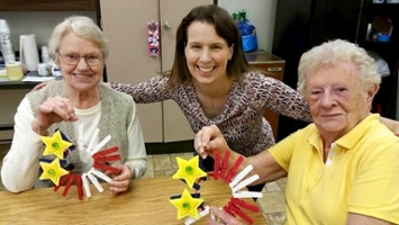A view toward independence: Pro bono services at low-vision clinic meant to preserve patient autonomy

Make a fist and bring it to the bridge of your nose. Now try to watch television or read a newspaper or view something on your computer screen. It's very difficult to see around that big, blank, fist-created space in the middle, isn't it?
Julie Ann Nastasi, ScD, OTD, faculty specialist in the University's Occupational Therapy Department, says this exercise helps students understand the challenges people with low vision face. In the fist-making example, the experience mimics age-related macular degeneration. Other conditions that create low vision are diabetic retinopathy and glaucoma. No matter its cause, patients are deemed to have low vision if their “best corrected” vision is 20/80 or worse. Best corrected means there's no longer recourse to a better prescription for eyeglasses. To get an idea of what 20/80 vision is, imagine the giant E on the very top of your eye doctor's chart. It represents 20/200; 20/80 hovers somewhere just below it.
Although people with low vision are not blind, daily tasks become quite difficult for them. However, with therapy and an adapted environment, there is no reason they cannot remain independent. Dr. Nastasi and her occupational therapy students have begun offering services at the University's Leahy Clinic designed to ensure that independence. A patient needs a prescription for occupational therapy and must be uninsured or under-insured to access the Leahy Clinic services.
The pro bono services offered at the clinic will help patients with low vision “use their remaining vision to stay independent,” Dr. Nastasi says. “Think about it. Ninety percent of what we do each day, from reading a prescription to paying bills, is processed through vision. With PRL (preferred retinal locus) training, people with macular degeneration can be taught to use other parts of their eye. We teach them to look to the left, look to the right, move that spot out of the way.”
In addition to therapy, patients can be taught to use adapted devices to compensate for impaired vision. For example, raised dots on machine dials can be used to help a person feel how to turn it on or off. There are playing cards featuring very large numbers. “The point of the low-vision clinic is to find out what's important to the patient and then help them find adaptations that will allow them to continue those activities,” Dr. Nastasi says.
Dr. Nastasi just began offering the Leahy Clinic services in October. She hopes to grow the program to about four hours each week and will include University OT students in the program. OT student and clinic volunteer, Christina Gavalas says, “Vision is such a central part of everyday functioning – it’s so rewarding knowing that we get to help people in need who might otherwise go without services. It means a lot that Dr. Nastasi has faith in us as future clinicians and wants to further our education by letting us observe and participate in her low-vision clinic.”
Referrals for the low-vision clinic have come from local optometrist and Scranton alumna, Nicole Beckish, OD. Dr. Nastasi also refers patients out, including to the Lackawanna Blind Association, where she and her graduate students regularly volunteer. Dr. Nastasi's volunteer work for Lackawanna Blind Association focuses on helping people who are completely blind concentrate on using their other senses to maintain independence.
“These volunteer services at our Sensory Development Activity Program exemplify the meaning of a true partnership with The University of Scranton students and a social service agency working together for the betterment of the blind and visually impaired in our community,” said Mary Lou Wascavich, executive director of the Lackawanna Blind Association.
[Photo Caption: Dr. Julie Nastasi looks on as Lackawanna Blind Association clients display Fourth of July wreaths they created during the association's Sensory Development program.]